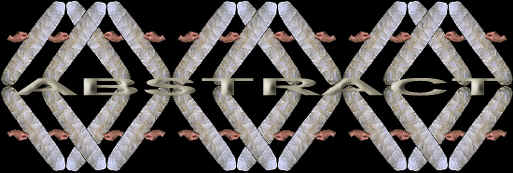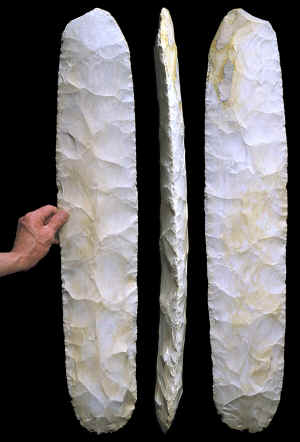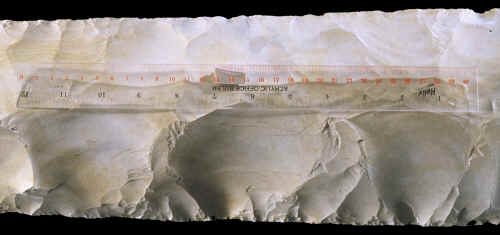|
PAGE
1
LARGE
BIFACE
MAYA CULTURE
BELIZE
A.D. 50 TO
A.D. 1400
PAGE 1
OF 1 PAGES

LARGE
BIFACE--EDGE VIEW
PRIVATE
COLLECTION
COPYRIGHT
FEBRUARY 29, 2004 PETER A. BOSTROM
|
|
|

|
|
LARGE
MAYA CULTURE BIFACE
BELIZE
This article illustrates a very large chert biface that is believed to have
come from a Mayan site in Belize. This artifact is unique for its
size and undamaged condition. It is made of a heavily patinated
piece of Colha chert. |
|
|
"---(the) non-committal term "biface"--can be applied to
specimens of any size, including the diminutive examples---".---1971,
M.D. Leaky, "Olduvai Gorge," vol. 3, p. 3.
"Strictly
speaking, (a biface is) an artifact that is flaked on two different
faces (surfaces)."---1988,
Tattersall, Delson & Couvering, "Encyclopedia of Human Evolution &
Prehistory" vol. 3, p.
91.

LARGE
BIFACE
MAYA CULTURE
BELIZE
Bifaces have been made for hundreds of thousands of years. The earliest
examples are hand axes that were made by Homo erectus 1.5 to 2 million
years ago. The example
illustrated here was made much more recently, sometime between
A.D. 50 and A.D. 1400 by a Mayan craftsmen. It's one of the largest "intact"
examples of a biface in the world. It apparently had no utilitarian
purpose because of its large size. There is no use wear on any of the
edges that might indicate cutting, scrapping or digging.
|
|

CLICK ON
PICTURE FOR LARGE TRIPLE IMAGE
LARGE BIFACE
MAYA CULTURE
BELIZE
PRIVATE COLLECTION
This picture shows three views of a large Maya culture biface.
It's made of heavily patinated Colha chert and weighs 19.7 lbs. (8.9
kg). There is no evidence that it was ever used for cutting or digging.
Some of the surface flake ridges are smoothed which might be the
result of transportation wear or some other form of handling.
This biface measures 32 1/2 inches (82.5cm) long, 5 7/8 inches
(15cm) wide and over 2 inches (5.1cm) thick. |
|
|
This Maya culture biface was made from a very large piece of Colha
chert. Some of the banding can barely be see through a very heavy
surface patina. The edge view shows that it does curve slightly,
indicating that it may have been made from a large flake that was struck
off of a much larger stone (core).
|
|

CLICK ON
PICTURE FOR LARGE IMAGE
LARGE BIFACE FLAKE REMOVALS
MAYA CULTURE
BELIZE
PRIVATE COLLECTION
This picture shows a magnified view of a series of three large
percussion flake scars on one of the edges of this extremely large
biface. These are very large flakes. In fact, each of these removed
flakes are larger than most "normal" size stone tools.
They were removed by striking the edge with a stone hammer.
This biface was probably made entirely with the use of a stone hammer
stone. |
|
|
Large bifaces have been found on Stone Age sites in the Americas near
locations where large quantities of workable stone was available.
The
largest bifaces in North America are found on the west coast in
California where late Stone Age people were using large pieces of
obsidian (volcanic glass).
The second largest flaked stone artifacts in North
America are the Mississippian spades from Late Stone Age sites
in the Central Mississippi Valley. Those people had access to a plentiful
supply of a tabular form of stone called Mill Creek chert. Even
farther south, into Kentucky and Tennessee, the Mississippian people
living there were making very long and narrow "dance swords"
made from a plentiful supply of Dover chert.
W.H.
Holmes, a noted archaeologist working for the Smithsonian Institution at
the turn of the last century, said, "among the most remarkable chipped
implements in America, and in the world for that matter, are the
obsidian blades of California, the largest of which are upward of 30
inches (76.2cm) in length--." This Maya culture biface is also
remarkable. At 32 1/2 inches (82.5cm)
long it is even longer than 30 inches (76.2cm) in length!
|
|
"REFERENCES"
1919,
Holmes, W.H, "Handbook of Aboriginal American Antiquities," pp. 214-216.
1971,
Leakey, M.D., "Olduvai Gorge," Vol. 3, p. 3.
1988, Tattersall, Ian, Delson, Eric & Couvering, John Van, "Encyclopedia of Human Evolution &
Prehistory," p. 91.
|
|
HOME
ORDERING |




